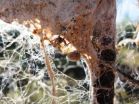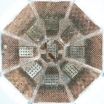(Press-News.org) At first glance, colonies of thousands of social spiders all look the same and are busy with the same tasks. Not so, says researchers Carl Keiser and Devin Jones of the University of Pittsburgh in the US, after carefully studying various gatherings of Stegodyphus dumicola social spiders of the Kalahari Desert in South Africa. The size and condition of a particular spider's body indicates which task it generally performs within a colony. In addition, neighboring colonies can have different "personalities" too, writes Keiser, lead author of a study published in Springer's journal Behavioral Ecology and Sociobiology.
Stegodyphus dumicola spiders live in colonies of up to 2,000 members in thorn trees in the arid parts of southwestern Africa. The spiders build large webs consisting of dense communal living areas and a two-dimensional capture web. To study them, Keiser and his colleagues transported various colonies collected in the southern Kalahari Desert to their laboratory at the University of Pittsburgh. They then carefully watched to what extent individuals were involved in tasks such as attacks, web building or web repairing.
Keiser and his colleagues believe that such studies are vital to understand how the traits and actions of individuals combine to form and develop the social organization and collective behavior of a particular species. In the case of Stegodyphus dumicola, the research group found that body size and body condition influence the chances that an individual spider will perform a range of tasks needed to maintain the colony. Spiders with smaller bodies are more likely to help with web building and maintenance. Those who are in better condition tend not to capture prey, while those with lower body condition are more likely to be busy with foraging.
A colony's "personality" or collective behavior is best predicted by the variety of individual spiders living within it. Colonies with members with different body sizes or aggression levels contain spiders which are slower to emerge from their nest to attack prey. Variation in boldness within colonies is in turn linked with better chances that more individual spiders will take part in standard web building activities.
"The results are intriguing because this trait variation and its resulting task differentiation gives rise to a cooperative breeding society composed of highly related, inbred individuals. The spiders are of nearly identical age and develop together in synchrony," explains Keiser. "Our findings differ from the once conventional reasoning among social spider researchers that social spider societies are homogenous and egalitarian."
INFORMATION:
Reference:
Keiser, C.N. et al (2014). Exploring the effects of individual traits and within-colony variation on task differentiation and collective behavior in a desert social spider, Behavioral Ecology and Sociobiology. DOI 10.1007/s00265-014-1696-9
The full-text article and a photo are available to journalists on request.
Size, personality matter in how Kalahari social spiders perform tasks
Study looks at division of tasks in colonies of southern African social spiders
2014-03-20
ELSE PRESS RELEASES FROM THIS DATE:
Swing voters hold more sway over candidates on economic issues
2014-03-20
CHAMPAIGN, Ill. — New research from two University of Illinois economics professors who study election trends analyzes how polarization on social issues affects competing candidates' economic platforms.
In the paper, co-authors Stefan Krasa and Mattias Polborn develop a theory of candidate competition that accounts for the influence of both economic and cultural issues on individual voting behavior.
"Many pundits and academics have argued that political polarization, particularly on social and cultural issues, has increased in the U.S.," said Polborn, also a professor ...
UTMB researchers discover a way to potentially slow down Alzheimer's
2014-03-20
Researchers at the University of Texas Medical Branch at Galveston have discovered a way to potentially halt the progression of dementia caused by accumulation of a protein known as tau.
Normally, tau protein is involved in microtubule formation, which acts as a brain cell's transportation system for carrying nutrients in and waste out. In the absence of tau protein, brain cells become dysfunctional and eventually die.
In many forms of dementia, such as Alzheimer's disease and chronic traumatic encephalopathy caused by multiple concussions, the tau protein starts behaving ...
What singing fruit flies can tell us about quick decisions
2014-03-20
You wouldn't hear the mating song of the male fruit fly as you reached for the infested bananas in your kitchen. Yet, the neural activity behind the insect's amorous call could help scientists understand how you made the quick decision to pull your hand back from the tiny swarm.
Male fruit flies base the pitch and tempo of their mating song on the movement and behavior of their desired female, Princeton University researchers have discovered. In the animal kingdom, lusty warblers such as birds typically have a mating song with a stereotyped pattern. A fruit fly's song, ...
As age-friendly technologies emerge, experts recommend policy changes
2014-03-20
From smart phones to smart cars, both public and private entities must consider the needs of older adults in order to help them optimize the use of new technologies, according to the latest issue of Public Policy & Aging Report (PP&AR), titled "Aging and Technology: The Promise and the Paradox." A total of eight articles all from authors affiliated with the Massachusetts Institute of Technology AgeLab are featured.
"Remarkable technological advances are all around us, and leaders in the business and scientific communities are keenly aware of 'the aging of America' and ...
A braking system for immune responses
2014-03-20
The surface of immune system cells is home to a number of receptors which are able to detect pathogens. As soon as these receptors are activated, inflammation occurs and the body's defense mechanisms kick in. Immune cells also have receptors that regulate or even suppress immunological responses to prevent damage to individual cells.
There are other immune receptors that recognize endogenous substances that are released when tissue damage or cell death occurs. As such, the organism can defend itself even in cases where the damage caused by the pathogen, but not the pathogen ...
(Not too) few but capable
2014-03-20
Until the '50s, bluefin tuna fishing was a thriving industry in Norway, second only to sardine fishing. Every year, bluefin tuna used to migrate from the eastern Mediterranean up to the Norwegian coasts. Suddenly, however, over no more than 4-5 years, the tuna never went back to Norway. In an attempt to solve this problem, Giancarlo De Luca from SISSA (the International School for Advanced Studies of Trieste) together with an international team of researchers (from the Centre for Theoretical Physics - ICTP – of Trieste and the Technical University of Denmark) started to ...
Inhibition of CDK4 might promote lymphoma development and progression
2014-03-20
COLUMBUS, Ohio – Anticancer agents that inhibit tumor growth by targeting a regulatory protein called CDK4 might actually promote the development and progression of certain B-cell lymphomas, according to a new study led by researchers at The Ohio State University Comprehensive Cancer Center – Arthur G. James Cancer Hospital and Richard J. Solove Research Institute (OSUCCC – James).
The study indicates that inhibiting CDK4, a regulator of the cell cycle, promotes genetic instability and the development or progression of B-cell lymphomas that are driven by the MYC oncogene.
The ...
Thoughtful people more likely to infer improvements in race relations
2014-03-20
According to a recent Pew Research poll, a majority of Americans believe that there is still at least some racism against African Americans in this country. But new research by Jane L. Risen of the University of Chicago Booth School of Business shows that people are more likely to deny the persistence of racism after being exposed to a successful African American. Notably, people who are most thoughtful seem to be the ones who are most vulnerable to making these quick inferences.
In "If He Can Do It, So Can They: Exposure to Counterstereotypically Successful Exemplars ...
Linking storms to climate change a 'distraction', say experts
2014-03-20
Connecting extreme weather to climate change distracts from the need to protect society from high-impact weather events which will continue to happen irrespective of human-induced climate change, say experts.
Writing in the journal Weather, Climate and Society, the University of Manchester researchers argue that cutting greenhouse gas emissions, while crucial to reducing humanity's longer-term impact on the planet, will not eliminate violent storms, tornadoes or flooding and the damage they cause.
The authors suggest that developing greater resilience to extreme weather ...
Prêt-à-fabriquer: Real-time simulation of textiles
2014-03-20
It is very costly to present textiles interactively on a computer screen. Until recently, this process often took several days to weeks. Using recently engineered simulation software, now this process takes just seconds. Designers, pattern makers and tailors can create their clothes in real time. Just as they do in reality. Besides needle and thread, the computer mouse is increasingly turning into one of their most indispensable tools. A few clicks suffice to make just the right adjustments to color, material and cut pattern. Shadowing, optical and mechanical qualities ...
LAST 30 PRESS RELEASES:
Tracing the quick synthesis of an industrially important catalyst
New software sheds light on cancer’s hidden genetic networks
UT Health San Antonio awarded $3 million in CPRIT grants to bolster cancer research and prevention efforts in South Texas
Third symposium spotlights global challenge of new contaminants in China’s fight against pollution
From straw to soil harmony: International team reveals how biochar supercharges carbon-smart farming
Myeloma: How AI is redrawing the map of cancer care
Manhattan E. Charurat, Ph.D., MHS invested as the Homer and Martha Gudelsky Distinguished Professor in Medicine at the University of Maryland School of Medicine
Insilico Medicine’s Pharma.AI Q4 Winter Launch Recap: Revolutionizing drug discovery with cutting-edge AI innovations, accelerating the path to pharmaceutical superintelligence
Nanoplastics have diet-dependent impacts on digestive system health
Brain neuron death occurs throughout life and increases with age, a natural human protein drug may halt neuron death in Alzheimer’s disease
SPIE and CLP announce the recipients of the 2025 Advanced Photonics Young Innovator Award
Lessons from the Caldor Fire’s Christmas Valley ‘Miracle’
Ant societies rose by trading individual protection for collective power
Research reveals how ancient viral DNA shapes early embryonic development
A molecular gatekeeper that controls protein synthesis
New ‘cloaking device’ concept to shield sensitive tech from magnetic fields
Researchers show impact of mountain building and climate change on alpine biodiversity
Study models the transition from Neanderthals to modern humans in Europe
University of Phoenix College of Doctoral Studies releases white paper on AI-driven skilling to reduce burnout and restore worker autonomy
AIs fail at the game of visual “telephone”
The levers for a sustainable food system
Potential changes in US homelessness by ending federal support for housing first programs
Vulnerability of large language models to prompt injection when providing medical advice
Researchers develop new system for high-energy-density, long-life, multi-electron transfer bromine-based flow batteries
Ending federal support for housing first programs could increase U.S. homelessness by 5% in one year, new JAMA study finds
New research uncovers molecular ‘safety switch’ shielding cancers from immune attack
Bacteria resisting viral infection can still sink carbon to ocean floor
Younger biological age may increase depression risk in older women during COVID-19
Bharat Innovates 2026 National Basecamp Showcases India’s Most Promising Deep-Tech Ventures
Here’s what determines whether your income level rises or falls
[Press-News.org] Size, personality matter in how Kalahari social spiders perform tasksStudy looks at division of tasks in colonies of southern African social spiders




